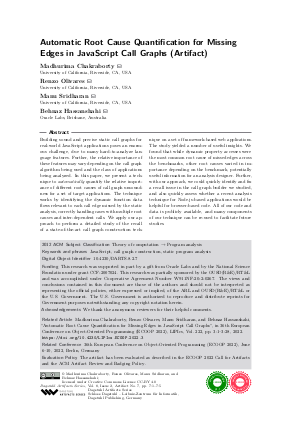@Article{chakraborty_et_al:DARTS.8.2.7,
author = {Chakraborty, Madhurima and Olivares, Renzo and Sridharan, Manu and Hassanshahi, Behnaz},
title = {{Automatic Root Cause Quantification for Missing Edges in JavaScript Call Graphs (Artifact)}},
pages = {7:1--7:5},
journal = {Dagstuhl Artifacts Series},
ISSN = {2509-8195},
year = {2022},
volume = {8},
number = {2},
editor = {Chakraborty, Madhurima and Olivares, Renzo and Sridharan, Manu and Hassanshahi, Behnaz},
publisher = {Schloss Dagstuhl -- Leibniz-Zentrum f{\"u}r Informatik},
address = {Dagstuhl, Germany},
URL = {https://drops.dagstuhl.de/entities/document/10.4230/DARTS.8.2.7},
URN = {urn:nbn:de:0030-drops-162052},
doi = {10.4230/DARTS.8.2.7},
annote = {Keywords: JavaScript, call graph construction, static program analysis}
}

 Creative Commons Attribution 4.0 International license
Creative Commons Attribution 4.0 International license

